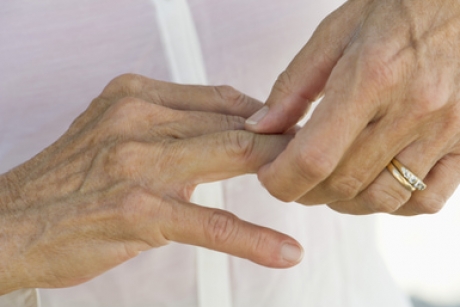Osteoarthritis is one of the most common forms of arthritis. It is a chronic condition in which the material that cushions the joints, called cartilage, breaks down. This causes the bones to rub against each other, causing stiffness, pain and loss of joint movement.
About 27 million people in the United States have osteoarthritis. Common risk factors include increasing age, obesity, previous joint injury, overuse of the joint, weak thigh muscles, and genetics.
Osteoarthritis symptoms usually develop gradually. At first, there may be soreness or stiffness that seems more like a nuisance than a medical concern.
Common symptoms include:
- Sore or stiff joints – particularly the hips, knees, and lower back – after inactivity or overuse.
- Stiffness after resting that goes away after movement.
- Pain that is worse after activity or toward the end of the day.
Osteoarthritis may also affect the neck, small finger joints, and the base of the thumb, ankle, or big toe. The pain may be moderate, and come and go, without affecting the ability to perform daily tasks. Some people with osteoarthritis never progress past this early stage. Others will feel their osteoarthritis get worse. The pain and stiffness of more severe osteoarthritis may make it difficult to walk, climb stairs, sleep, or perform other daily tasks.
There is no cure for osteoarthritis, but there are medications to help relieve pain, when needed. Your doctor may recommend physical therapy or occupational therapy to help improve strength and function. When pain is severe and frequent, or mobility and daily activities become difficult, surgery may be considered.
People with osteoarthritis who have severe joint damage, extreme pain that isn’t helped by other treatments, or very limited motion as a result of the condition, may require osteoarthritis surgery.
Surgery for osteoarthritis can provide several benefits, including the following:
Improved movement: If the constant erosion of cartilage makes it difficult for you to move, making it difficult to you to get around and stay independent, replacing the damaged joint with a synthetic one can allow you to continue activities that you enjoy.
Pain relief: If osteoarthritis causes severe, constant pain that isn’t relieved by treatments such as medications, exercise or physical therapy, surgically replacing the painful joint or removing loose growths that are causing pain, can relieve pain.
Improved joint alignment: In some cases, osteoarthritis can cause the joint to become maligned so that it no longer functions as it should and looks unusual. In the knees, surgery can correct or improve this misalignment. But appearance should not be the main reason for having surgery for osteoarthritis; improved appearance should be considered a bonus after osteoarthritis surgery improves movement and relieves pain.
Staying physically active and maintaining a healthy weight are the keys to living well with osteoarthritis. Too little movement can lead to stiffness and weak joints. Losing one pound can take four pounds of pressure off your knee joints. Overall fitness improves health in many ways. Strong muscles protect joints. An osteoarthritis management plan also involves eating a nutritious diet, managing stress and depression, and getting a good balance of rest and activity each day.
If you think you may have osteoarthritis, and if osteoarthritis runs in your family, set up an appointment with an orthopedic specialist today to help manage your condition and maximize your quality of life.

